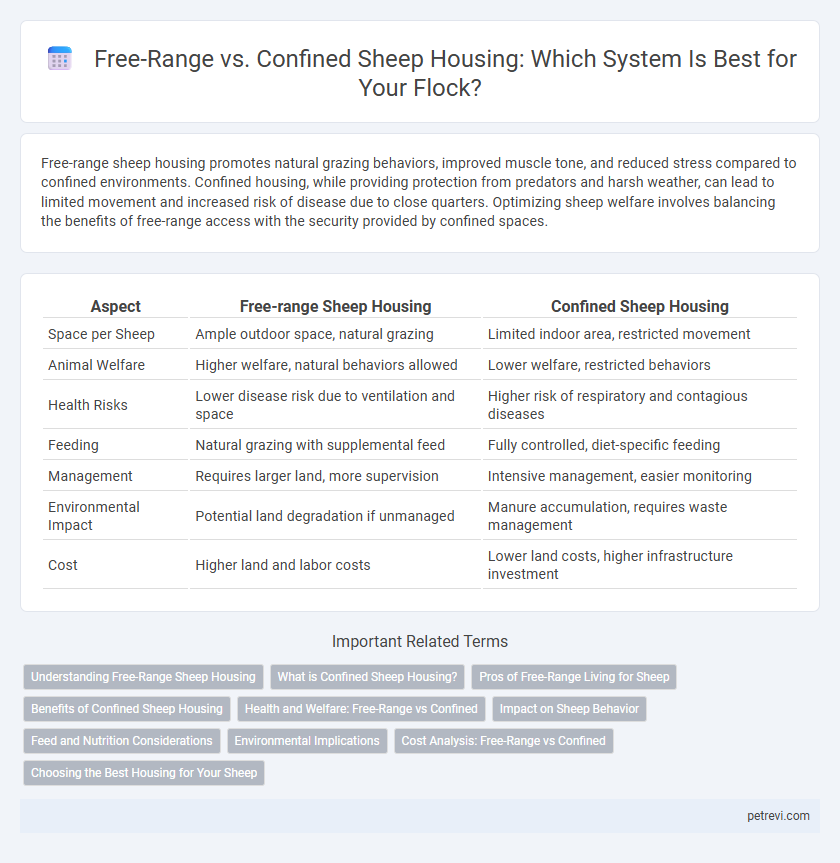Free-range sheep housing promotes natural grazing behaviors, improved muscle tone, and reduced stress compared to confined environments. Confined housing, while providing protection from predators and harsh weather, can lead to limited movement and increased risk of disease due to close quarters. Optimizing sheep welfare involves balancing the benefits of free-range access with the security provided by confined spaces.
Table of Comparison
| Aspect | Free-range Sheep Housing | Confined Sheep Housing |
|---|---|---|
| Space per Sheep | Ample outdoor space, natural grazing | Limited indoor area, restricted movement |
| Animal Welfare | Higher welfare, natural behaviors allowed | Lower welfare, restricted behaviors |
| Health Risks | Lower disease risk due to ventilation and space | Higher risk of respiratory and contagious diseases |
| Feeding | Natural grazing with supplemental feed | Fully controlled, diet-specific feeding |
| Management | Requires larger land, more supervision | Intensive management, easier monitoring |
| Environmental Impact | Potential land degradation if unmanaged | Manure accumulation, requires waste management |
| Cost | Higher land and labor costs | Lower land costs, higher infrastructure investment |
Understanding Free-Range Sheep Housing
Free-range sheep housing allows sheep to graze naturally on open pastures, promoting better animal welfare and healthier wool production through increased movement and access to fresh air. This method reduces stress and the risk of diseases common in confined settings by enabling natural behaviors like foraging and social interaction. Effective free-range systems require well-maintained fencing, shelter from extreme weather, and rotational grazing strategies to balance pasture health and sheep nutrition.
What is Confined Sheep Housing?
Confined sheep housing refers to an intensive system where sheep are kept in enclosed spaces such as barns or pens, limiting their free movement and access to natural grazing. This method controls environmental conditions, reduces parasite exposure, and facilitates easier management of feeding, health monitoring, and breeding. However, confined housing requires proper ventilation, waste management, and space allocation to prevent stress and disease among the flock.
Pros of Free-Range Living for Sheep
Free-range sheep housing promotes natural grazing behavior, enhancing animal welfare and reducing stress-related health issues. Access to diverse pasture improves sheep nutrition by providing a variety of plants rich in essential nutrients and minerals. Free-range systems also contribute to sustainable land management through natural fertilization and parasite control.
Benefits of Confined Sheep Housing
Confined sheep housing improves flock health by reducing exposure to predators and harsh weather, leading to lower mortality rates and enhanced animal welfare. Controlled environments facilitate better nutrition management and disease prevention through regular monitoring and sanitation. This housing method also optimizes space efficiency and supports easier lambing supervision and feeding routines.
Health and Welfare: Free-Range vs Confined
Free-range sheep typically exhibit better overall health and welfare due to increased access to natural grazing, exercise, and fresh air, which reduces stress and the incidence of respiratory diseases. Confined housing often leads to higher risks of parasite infestations, lameness, and behavioral issues stemming from limited movement and poor ventilation. Optimizing sheep welfare depends heavily on providing an environment that supports natural behaviors and minimizes exposure to pathogens.
Impact on Sheep Behavior
Free-range sheep exhibit more natural behaviors such as grazing, social interaction, and exploration, which promote physical health and reduce stress. Confined housing restricts movement, leading to increased aggressive behaviors and potential health issues due to limited space and environmental enrichment. Studies show that free-range environments enhance overall welfare by supporting instinctual activities critical for sheep well-being.
Feed and Nutrition Considerations
Free-range sheep benefit from diverse forage, enhancing nutritional intake through natural grazing on grasses, legumes, and herbs, which provide essential vitamins and minerals absent in confined diets. Confined sheep require carefully formulated feed rations rich in energy, protein, and fiber to meet their nutritional needs, often supplemented with minerals and vitamins to prevent deficiencies. Efficient feed management in both systems is critical to maintaining optimal health, growth rates, and wool quality.
Environmental Implications
Free-range sheep housing promotes biodiversity by maintaining natural pasture ecosystems and reducing soil erosion through rotational grazing practices. Confined housing concentrates waste, increasing risks of water contamination from manure runoff and requiring energy-intensive waste management systems. Free-range systems generally have a lower carbon footprint due to decreased reliance on mechanical ventilation and artificial feed inputs.
Cost Analysis: Free-Range vs Confined
Free-range sheep housing often incurs higher initial land and predator management costs but reduces expenses related to ventilation and bedding compared to confined systems. Confined housing demands significant investment in infrastructure, feed delivery, and waste management, increasing operational costs but allowing for more controlled feeding and breeding conditions. Long-term cost analysis favors free-range systems where natural foraging reduces feed costs, while confined systems may lead to higher disease management expenses.
Choosing the Best Housing for Your Sheep
Free-range housing allows sheep to graze naturally, promoting better muscle development and reducing stress-related health issues. Confined housing offers protection from predators and harsh weather but requires rigorous sanitation to prevent disease outbreaks. Optimal sheep housing balances space, shelter, and ventilation to ensure welfare and productivity.
Free-range vs Confined for Sheep Housing Infographic

 petrevi.com
petrevi.com